Yeovil Trades & Traders
Francis W Gaylard
Hairdresser of Hendford and Princes Street
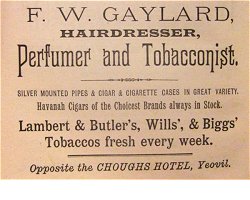 Francis W
Gaylard, known
as Frank, was born
in 1852 in
Yeovil. By the
late 1870's he
had established
himself as a
hairdresser,
initially in
premises
opposite the
Three Choughs
in
Hendford.
Francis W
Gaylard, known
as Frank, was born
in 1852 in
Yeovil. By the
late 1870's he
had established
himself as a
hairdresser,
initially in
premises
opposite the
Three Choughs
in
Hendford.
In this Whitby's Yeovil Almanack Advertiser advertisement of 1888 at left, while at his premises in Hendford, he also advertised himself as a perfumer and tobacconist but, more interestingly, he advertised his use of "Hair Brushing Machinery Driven by Bailey's Patent Hydraulic Engine". It is illustrated in use in his advertisement below with, presumably, Francis Gaylard himself using it.
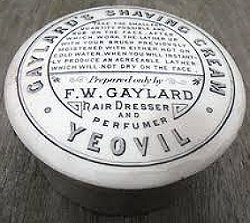 In the 1891 census Frank
Gaylard was
listed as living
in Hendford with
his wife Julia
and their five
children and a
domestic
servant. Frank
was listed as a
hairdresser and
all the children
were listed as
scholars.
In the 1891 census Frank
Gaylard was
listed as living
in Hendford with
his wife Julia
and their five
children and a
domestic
servant. Frank
was listed as a
hairdresser and
all the children
were listed as
scholars.
Frank was also a longstanding member of the Yeovil Lodge of Freemasons and was Worshipful Master from 1895 to 1898.
By the 1901 census Francis Gaylard was living in Princes Street with Julia and their children; 25-year old draper's assistant Mabel, 21-year old Lilian, Ethel aged 15, 19-year old William. and a general domestic servant. William was listed as a hairdresser's assistant and Lilian was listed as a hairdresser's shop assistant. Their eldest son, Stanley, had left home by this time.
gallery
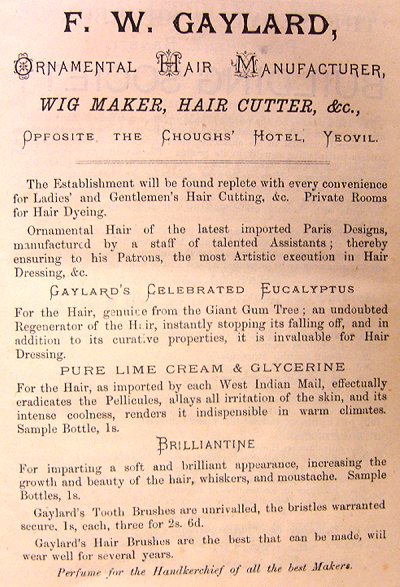
One of Francis Gaylard's earliest advertisements, from the 1878 edition of Whitby's Yeovil Almanack Advertiser, and probably his most flowery prose.
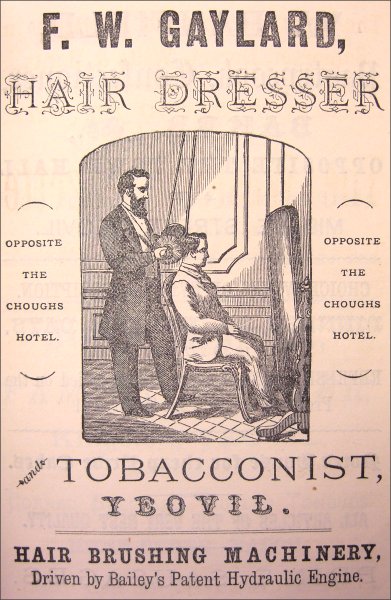
Francis Gaylard's advertisement in the 1881 edition of Whitby's Yeovil Almanack Advertiser, by which time he had moved to Hendford, opposite the Three Choughs. The advertisement features hair brushing machinery driven by Bailey's Patent Hydraulic Engine and the illustration shows it in use.
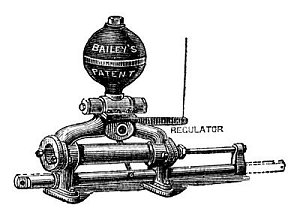 The
Bailey Patent
Hydraulic Engine
was manufactured
by W H Bailey &
Co of Albion
Works, Salford,
Manchester; they
were well-known
hydraulic
Engineers,
making hydraulic
lifts and
hoists.
The
Bailey Patent
Hydraulic Engine
was manufactured
by W H Bailey &
Co of Albion
Works, Salford,
Manchester; they
were well-known
hydraulic
Engineers,
making hydraulic
lifts and
hoists.
The engine used a double-acting cylinder to oscillate the rod at the bottom of the assembly. This rod would be connected to a bellows or other such device; a small lever connected to it operated the valve above the cylinder. The regulator lever was worked by the rise and fall of the air accumulator, controlling the water supply appropriately. The sphere at the top is an air-vessel to minimise water-hammer.
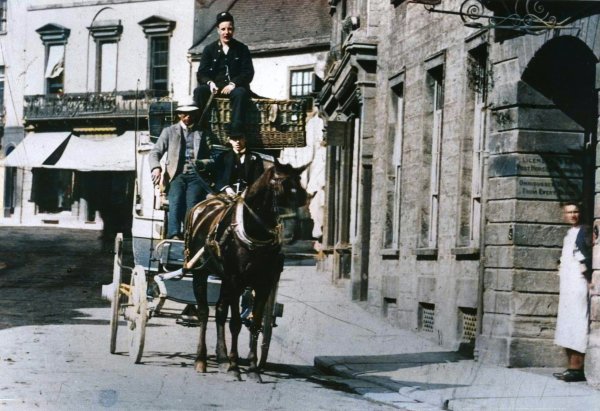
From the Cave
Collection
(colourised),
Courtesy of South Somerset Heritage Collection
In this photograph, dating to the early 1890's, just above the cab diver's head is painted a sign "Gaylard's Hair Cutting Rooms" with an arrow pointing down. His earlier establishment in Hendford was just out of shot at extreme left in this photograph.
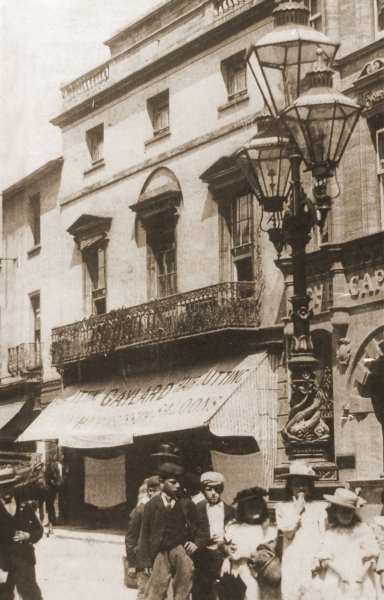
This photograph dates to after 1897 when the Capital and County Bank opened on the corner of Princes Street and High Street, just visible at extreme right behind the three-light Sugg lamp erected to celebrate Queen Victoria's diamond jubilee. Gaylard's name is proudly displayed on his hairdressing saloon's awning.
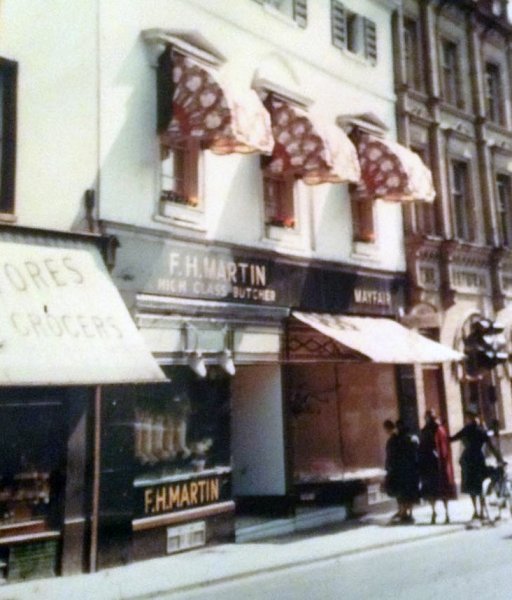
Courtesy of
Geoffrey White
By the 1960s the ground floor of Mayfair had been divided into two shop premises; FH Martin butchers and Mayfair dress shop.
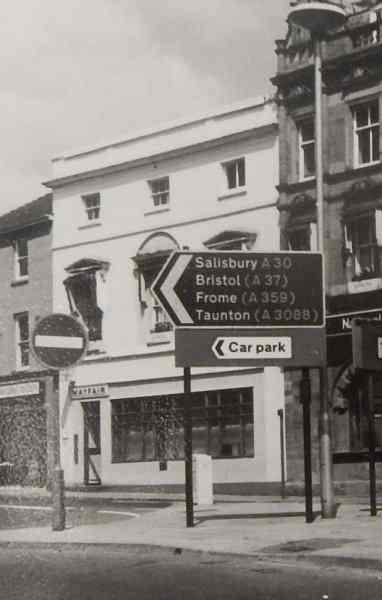
In the early 1970s the face of Mayfair changed yet again.
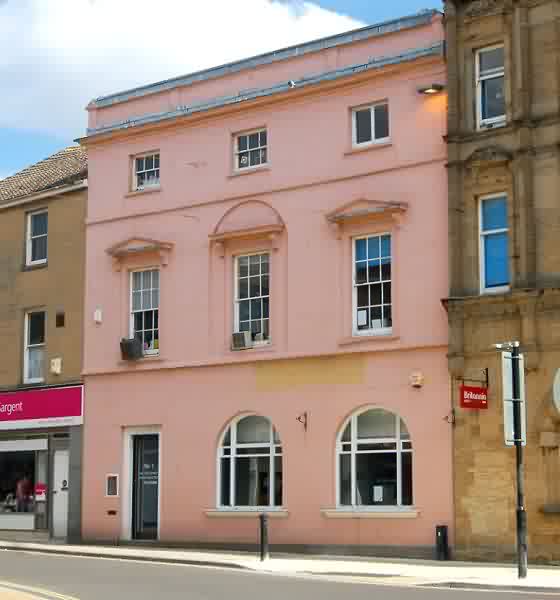
Mayfair photographed in 2014. Today the building has been stripped of most of its architectural detail, a butchered ground floor elevation and painted a ghastly shade of pink - completely out of character for such a once-elegant building.